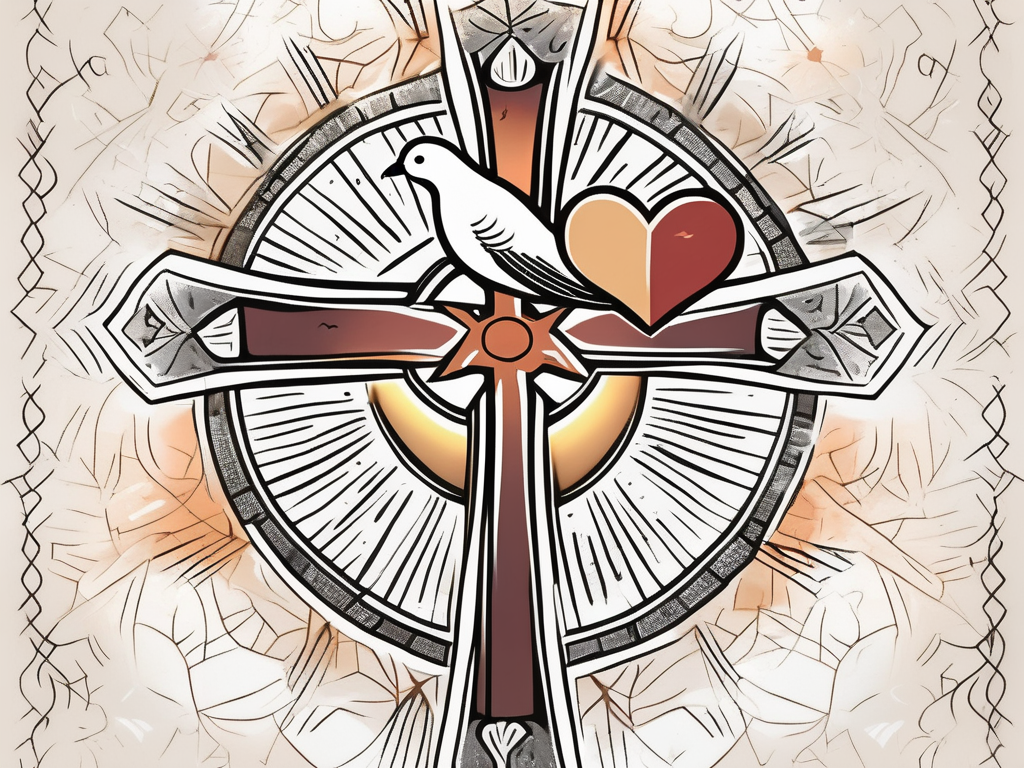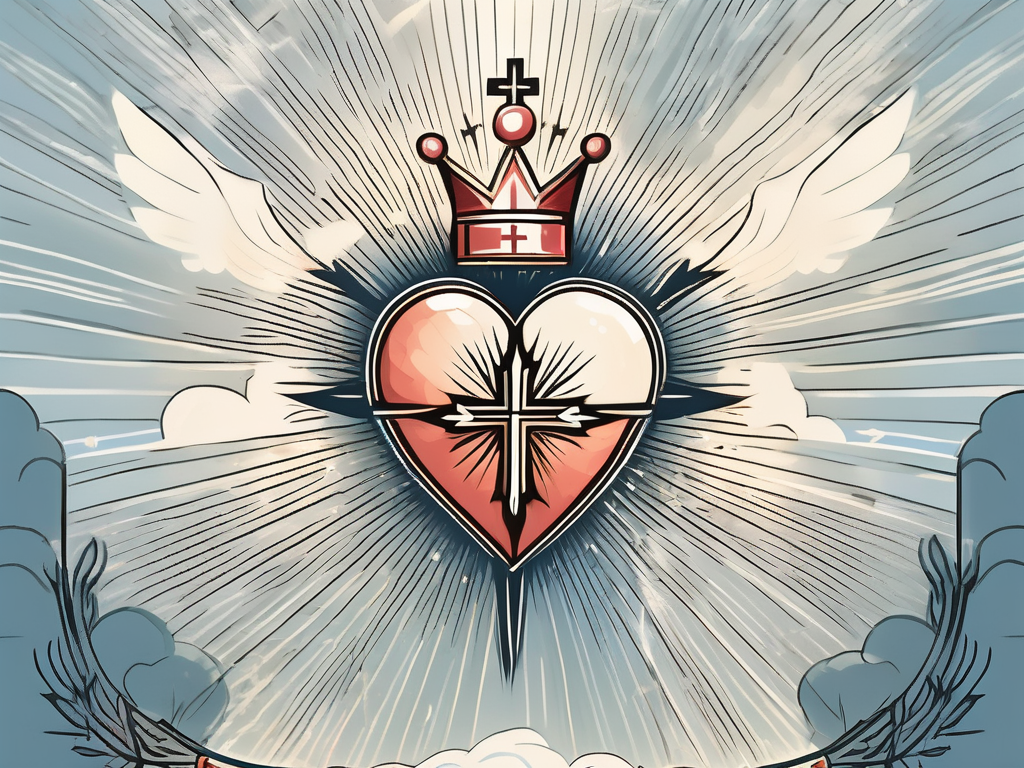In Christianity, the cross holds a deep and profound significance. It is more than just a symbol or a piece of jewelry. The cross is a powerful representation of faith, love, sacrifice, redemption, and so much more. Throughout the centuries, it has been at the heart of Christian theology, art, and rituals. Let’s delve into the different aspects of what the cross symbolizes in Christianity.
Understanding the Significance of the Cross
Before we explore the historical and theological interpretations, it is important to grasp the overall significance of the cross in Christianity. The cross is a reminder of Jesus Christ’s ultimate sacrifice on behalf of humanity. It serves as a powerful symbol of hope, forgiveness, and salvation. It represents the central message of the Christian faith – that through Christ’s death and resurrection, believers are reconciled with God and granted eternal life.
When we delve deeper into the significance of the cross, we uncover a rich tapestry of meaning that has shaped the beliefs and practices of Christians throughout history. Let us now embark on a journey to explore the historical context, the symbol of sacrifice, and the symbol of redemption associated with the cross.
The Historical Context of the Cross
To fully appreciate the significance of the cross, it is crucial to understand its historical context. The Romans used crucifixion as a form of execution during the time of Jesus. When Jesus was crucified on a cross, it was a brutal and agonizing death. The cross, originally a symbol of shame and punishment, transformed into a symbol of triumph over sin and death.
As we reflect on the historical context of the cross, we gain a deeper understanding of the immense suffering and sacrifice that Jesus endured. It was on the cross that he bore the weight of humanity’s sins, offering himself as a sacrificial lamb to bring about redemption and reconciliation.
The Cross as a Symbol of Sacrifice
One of the central meanings of the cross is its representation of sacrifice. Jesus willingly laid down his life on the cross as a perfect and pure sacrifice for the sins of humanity. This act of selflessness demonstrated God’s immense love for humanity and provided a way for reconciliation between God and humans.
When we contemplate the cross as a symbol of sacrifice, we are reminded of the depth of God’s love and the lengths to which he was willing to go to restore our broken relationship with him. The cross stands as a testament to the ultimate act of love and self-sacrifice, inspiring believers to live lives of gratitude and service to others.
The Cross as a Symbol of Redemption
Beyond sacrifice, the cross symbolizes redemption. Through Jesus’ death and resurrection, believers are redeemed from their sins and offered the opportunity for a renewed relationship with God. The cross serves as a constant visual reminder of God’s forgiveness and grace.
When we gaze upon the cross, we are reminded that our past mistakes and shortcomings do not define us. The cross represents a fresh start, a chance to be reconciled with God and experience the transformative power of his love. It is through the cross that we find hope, healing, and the promise of eternal life.
As we conclude our exploration of the significance of the cross, we are left in awe of the profound impact this symbol has had on the lives of countless believers throughout history. It serves as a beacon of hope, a reminder of God’s love, and a call to live lives that reflect the sacrificial love of Jesus. May we never lose sight of the cross and its enduring significance in our faith journey.
Theological Interpretations of the Cross
As Christianity developed, different theological interpretations of the cross emerged within various denominations. Let’s take a closer look at some of these interpretations.
The cross, a powerful symbol of Christianity, has been interpreted in diverse ways by different branches of the faith. Each interpretation brings its own unique perspective and understanding of the significance of the cross in the life of believers.
The Cross in Catholicism
In Catholicism, the cross holds a central place in worship and devotion. It is often adorned with a crucifix, which depicts the body of Christ. Catholics view the cross as a sacramental reminder of Christ’s sacrifice and a symbol of hope and salvation.
For Catholics, the crucifix serves as a visual representation of the immense love and sacrifice of Jesus Christ. It is a constant reminder of the suffering and death that He endured for the redemption of humanity. The crucifixion is seen as the ultimate act of love and selflessness, and the cross serves as a focal point for prayer and contemplation.
Furthermore, the cross in Catholicism is not just a historical event but a present reality. It is believed that through the celebration of the Eucharist, the sacrifice of Christ on the cross is made present again, offering believers the opportunity to participate in His redemptive work.
The Cross in Protestantism
Protestant interpretations of the cross vary within different denominations, but they generally emphasize salvation through faith alone. The simplicity of the empty cross is often highlighted, representing the triumph of Christ over sin and death.
Protestants place great emphasis on the concept of grace and believe that salvation is a gift from God, received through faith in Jesus Christ. The cross, in this context, serves as a reminder of God’s unconditional love and the forgiveness of sins that believers receive through Christ’s sacrifice.
The empty cross, devoid of the crucifix, symbolizes the resurrection and victory over death. It represents the hope and new life that believers have in Christ, as well as the assurance of eternal salvation.
The Cross in Orthodox Christianity
In Orthodox Christianity, the cross is highly revered and venerated. It is viewed as a sign of victory and a reminder of Christ’s redemptive work. The Orthodox tradition often depicts the crucifixion in intricate and elaborate iconography.
Orthodox Christians see the cross as a symbol of triumph over sin, death, and the powers of darkness. It is a powerful reminder of Christ’s victory on the cross and His conquering of evil. The crucifixion is seen as the ultimate act of love and sacrifice, demonstrating God’s infinite mercy and compassion for humanity.
In Orthodox worship, the cross is often adorned with precious metals and jewels, reflecting the belief that Christ’s sacrifice is of immeasurable value. The intricate iconography surrounding the cross serves as a visual representation of the profound theological truths that the cross embodies.
Orthodox Christians often make the sign of the cross as a gesture of reverence and devotion, acknowledging the presence and power of Christ’s sacrifice in their lives.
The Cross in Christian Art and Architecture
Throughout history, the cross has been a prominent motif in Christian art and architecture. It has evolved alongside the development of artistic styles and cultural contexts.
The cross, a symbol of Christianity, holds deep significance and meaning for believers around the world. It represents the central event of the Christian faith – the crucifixion of Jesus Christ and his subsequent resurrection. As such, it has been a source of inspiration for artists and architects throughout the centuries.
The Cross in Early Christian Art
Early Christian art predominantly showcased the cross in subtle and symbolic ways. It was often represented through abstract symbols like the anchor or the chi-rho monogram, hinting at the cross’ significance without explicitly depicting the crucifixion.
These early representations of the cross were influenced by the need to protect the Christian community from persecution. In a time when Christianity was not yet widely accepted, artists had to convey their faith discreetly. The use of abstract symbols allowed them to communicate the message of the cross without drawing unwanted attention.
The Cross in Medieval Christian Art
During the medieval period, the crucifixion became a more prevalent subject in Christian art. Artists portrayed the suffering and sacrifice of Christ on the cross with great attention to detail, aiming to evoke a sense of devotion and contemplation among viewers.
Medieval artists sought to create a connection between the viewer and the divine through their depictions of the cross. The intricate details of the crucifixion scene, from the wounds on Christ’s body to the expressions of anguish on his face, were meant to elicit a strong emotional response. The goal was to inspire piety and encourage a deeper understanding of the significance of Christ’s sacrifice.
The Cross in Modern Christian Art
In modern Christian art, artists have experimented with numerous styles and interpretations of the cross. Some integrate traditional imagery with contemporary elements, while others explore abstract representations to convey the cross’ universal and timeless message.
Contemporary artists often use the cross as a metaphor for various aspects of human existence. They explore themes such as suffering, redemption, and hope through their artistic interpretations. By incorporating different materials, textures, and colors, they aim to engage viewers in a dialogue about the relevance and enduring power of the cross in today’s world.
Moreover, the cross has also found its way into Christian architecture. Churches, cathedrals, and other religious structures often feature cross-shaped floor plans or incorporate cross motifs into their design elements. These architectural choices serve as a constant reminder of the central role the cross plays in the Christian faith.
Overall, the cross continues to be a powerful symbol in Christian art and architecture. It serves as a visual representation of the core beliefs and teachings of Christianity, and its varied interpretations throughout history reflect the ever-evolving nature of artistic expression.
The Cross in Christian Rituals and Practices
Besides its representation in art, the cross plays a significant role in Christian rituals and practices.
One of the most common practices among Christians, particularly in Catholicism and Orthodox Christianity, is the sign of the cross. This ritual involves tracing the shape of the cross over one’s body, symbolizing a personal connection with Christ’s sacrifice and invoking divine protection. The sign of the cross is a powerful gesture that reminds believers of their faith and the ultimate sacrifice made by Jesus on the cross.
In addition to its significance in personal devotion, the cross also holds a special place in the sacraments of baptism and confirmation. During these ceremonies, the cross is often present in the liturgy and symbols used. It serves as a reminder of the believer’s identification with Christ’s death and resurrection, and the new life they receive through these sacraments. The cross is a visible representation of the believer’s commitment to following Christ and living a life of faith.
Furthermore, the cross is an integral part of Christian worship and prayer. It can be found in various forms throughout these practices. For example, the cross is prominently displayed on altars, serving as a focal point during worship services. It is also present in hymns, where believers sing praises to God and reflect on the significance of the cross. Additionally, the cross can be seen on liturgical garments worn by clergy, symbolizing their role as representatives of Christ. Some churches even have a cross-shaped layout, with the building itself forming the shape of the cross, creating a sacred space for worship.
The cross symbolizes a multitude of profound meanings in Christianity. From sacrifice and redemption to hope and salvation, it serves as a visual and spiritual reminder of Jesus Christ’s love for humanity. Whether depicted in art, worn as a personal ornament, or incorporated into rituals, the cross remains an enduring and significant symbol that speaks to the heart of the Christian faith.












